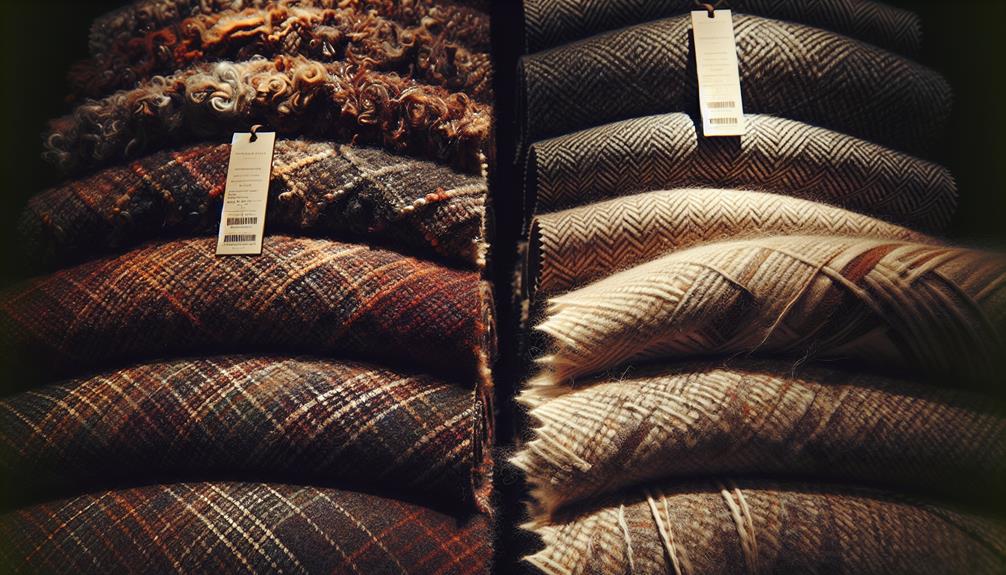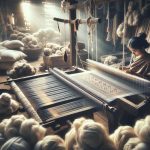So, I've been looking into why tweed often comes with a heftier price tag compared to regular wool. It turns out, the whole process of making tweed is way more complex. We're talking about specific weaving techniques and some pretty unique patterns that aren't as simple as what you see in typical wool production. Plus, tweed has a bit of a status symbol vibe, which probably adds to the cost. Makes you wonder, doesn't it? How much more are we paying for the allure of tweed, and is it really worth it when you compare it to other wool fabrics? Let's unpack this a bit more.
Table of Contents
Key Takeaways
- Tweed typically costs more due to its intricate weaving patterns and labor-intensive production.
- The scarcity of specific high-quality wool types used in tweed contributes to its higher price.
- Tweed's complex production processes, involving dense and multicolored threads, increase manufacturing costs.
- Market demand for tweed's unique, handmade characteristics can drive up its price compared to more standard wool fabrics.
- The cultural and historical significance of tweed, especially from regions like Harris, adds to its premium pricing.
Understanding Tweed and Wool
Before we explore comparing costs, let's clarify what we're discussing: tweed is a type of woolen fabric, not a completely distinct material from wool. Now, when you're examining tweed, you're basically dealing with a wool fabric that's woven with a soft, open, flexible texture, often featuring mixed flecks of color through different weaving techniques. This gives tweed its unique and often complex appearance.
Understanding these fabric characteristics is important because they directly influence both the aesthetic appeal and the functional capabilities of the fabric. Tweed is renowned for its durability and moisture-resistant properties, making it especially popular for outdoor use in colder climates.
Let's talk care instructions. Tweed requires a bit of know-how to maintain its distinctive look. Generally, it's best to dry-clean tweed to preserve its texture and color vibrancy. Frequent washing or improper handling can cause the fabric to lose its characteristic rough texture. If you must tackle a stain at home, spot clean gently rather than washing the entire garment.
Grasping these aspects helps us appreciate why tweed might be priced differently compared to other wool fabrics. It's not just about material cost—it's also about the craftsmanship and handling required.
Origins of Tweed Fabric
Let's kick off by looking at where tweed came from.
We'll explore its historical roots, check out the main areas where it was produced, and see how it was first made.
Understanding these points helps us get why tweed might be priced differently from plain wool.
Tweed's Historical Roots
Tweed originated in Scotland and Ireland as a durable fabric worn by rural workers. Initially, it was essential for shielding them from harsh, wet climates.
As I explore its historical roots, it's evident that tweed's popularity soared beyond mere practicality. By the 19th century, it became a symbol of rustic sophistication among the British elite, further elevating its cultural significance.
This transformation wasn't just about fashion; it highlighted tweed as a marker of identity and class distinction. Significantly, its adoption by the aristocracy and its use in activities like hunting and shooting cemented its status.
Understanding this shift helps us appreciate not only the fabric's utility but also its profound impact on social and cultural fabrics.
Geographical Production Areas
Now, I'll explore where tweed is traditionally produced, focusing on its specific geographical origins.
Tweed's roots are deeply embedded in Scotland and Ireland, regions known for their damp, cool climate. This climate influence is essential as it gives the fabric its moisture-resistant qualities, making it ideal for the local weather.
The Outer Hebrides in Scotland, especially the Isle of Harris, is famed for Harris Tweed, a premium type often associated with the fabric. The production of tweed has traditionally bolstered local economies, providing employment and sustaining small communities in these areas.
It's not just a fabric; it's a lifeline for many, intertwining cultural heritage with economic necessity in places where such opportunities might be sparse.
Early Manufacturing Techniques
Delving into its origins, we find that tweed was initially handwoven by locals using wool from their own sheep. This craft was deeply rooted in rural communities, particularly in Scotland and Ireland, where the natural resources for wool production were abundant. Early tweed manufacturing was labor-intensive, relying heavily on skilled weavers to produce the durable, water-resistant fabric that's familiar to us today.
As industrial advancements began to transform the textile industry, new machinery like the power loom made tweed production faster and less reliant on manual labor. These changes drastically altered labor practices, shifting the industry from artisanal home weaving to more centralized factory settings. This evolution marked a significant shift in how tweed was produced, impacting both its quality and cultural significance.
How Wool Is Produced
Sheep are sheared annually to collect the raw wool that begins the production process. I've seen various sheep shearing methods in action—it's fascinating stuff. Typically, shearers use electric clippers, which are efficient but require skill to avoid injuring the sheep. Some folks still use manual shears, especially in smaller flocks, which lessens the environmental impact by reducing electricity usage.
After shearing, the wool goes through sorting. Here, I've noticed workers separating wool based on quality and part of the body it comes from. This step is vital because it determines the end use of the wool—whether it'll end up in fine clothing or more rugged uses like carpeting.
Next up, the wool is cleaned, or 'scoured,' to remove natural oils and dirt. This process uses a fair amount of water and detergents, which I'm always a bit wary of due to the potential environmental impact. The industry is, however, moving towards more sustainable practices, like using biodegradable detergents and recycling water.
Factors Affecting Fabric Costs
When I examine why some fabrics are pricier than others, I can't overlook factors like the quality of the raw materials used.
The complexity of the production process plays a huge role as well.
Additionally, we must take into account how market demand trends impact costs.
Raw Material Quality
The quality of the raw materials greatly impacts the cost of fabrics like tweed and wool. When it comes to material sourcing, the origin and quality of the fibers play a huge role. For tweed, the wool often comes from specific breeds of sheep known for their durable, high-quality wool. These quality metrics guarantee that the tweed isn't only strong but also maintains its texture and color over time.
Similarly, wool fabrics vary widely based on the sheep's breed and the conditions in which they were raised. Higher-quality wool, which is softer and more resilient, generally costs more. Understanding these factors helps us grasp why some tweed or wool garments carry a heftier price tag than others.
Production Complexity
Understanding the complexities involved in producing tweed and wool can greatly explain their costs. Both these textiles have their own unique production methods, but it's the labor intensity and material scarcity that notably bump up the price for tweed. Let's break it down.
Wool production is straightforward but labor-intensive, involving shearing, cleaning, and spinning. Tweed, however, takes it up a notch. Its production not only includes all these steps but also intricate weaving patterns and often a denser, multicolored qthread use, which requires more skill and time.
Material scarcity plays a role too. The specific wool types needed for high-quality tweed are less common, making them pricier. Both fabrics demand a lot, but tweed's complexity and material needs make it generally more expensive.
Market Demand Trends
Now, let's explore how market demand trends also play a substantial role in shaping the costs of tweed and wool fabrics. Consumer preferences hugely impact these trends. As tastes shift towards sustainable and unique textiles, tweed, often handmade and distinctive, can see a spike in demand, thereby driving up prices. Wool, while always popular, experiences price fluctuations based on how consumers view its environmental impact and production ethics.
Seasonal influences also can't be ignored. Demand for wool typically increases in colder months, leading to higher prices in autumn and winter. Conversely, tweed, being a staple in both fashion and function during these seasons, also sees its value peak. Understanding these trends helps us grasp why prices for these fabrics might vary significantly throughout the year.
Durability and Longevity Comparison
When comparing the durability of tweed to wool, tweed often proves to be more essential and long-lasting. Let's explore why that's the case. Tweed, typically made from tightly woven wool, incorporates multiple yarns which enhance its ability to withstand wear and tear. This rugged construction translates into superior durability, meaning your tweed jacket can handle more rough and tumble than a standard wool sweater.
Now, considering the care instructions, tweed isn't high-maintenance despite its tough character. It generally requires less frequent washing, which not only makes it more practical but also reduces its environmental impact. Less washing means reduced water usage and lower detergent pollutants released into ecosystems.
The weave of tweed also plays a vital role in its longevity. The complex, dense weave protects the fibers from breaking down too quickly, allowing it to maintain its shape and texture through numerous seasons. So, while you might pay more upfront for a tweed item, the investment pays off with years of use, making it a smart buy in the long run.
All in all, if you're after a fabric that combines resilience with a lighter ecological footprint, tweed is certainly worth considering over plain wool.
Style and Aesthetic Differences
Beyond durability, tweed also stands out for its distinctive style and aesthetic appeal compared to plain wool. Tweed, with its textured weaves and depth, offers more visual interest and versatility. When I'm choosing an outfit, the color variations in tweed make it a real standout. Unlike the often uniform hue of plain wool, tweed can incorporate multiple colors in a single weave, creating a rich, multi-dimensional look. This factor alone can elevate an outfit, making it more visually engaging and unique.
Staying on top of fashion trends, I've noticed that tweed has consistently held a place in both classic and contemporary wardrobes. It's not just about the old-school jackets anymore; designers are crafting everything from tweed trousers to accessories, showing its range beyond traditional uses. What's great is that tweed blends seamlessly with modern or vintage styles, making it incredibly adaptable. Whether I'm aiming for a sophisticated, professional look or something more laid-back and rustic, tweed fits the bill perfectly.
The aesthetic flexibility of tweed, combined with its rich palette of textures and colors, clearly sets it apart from plain wool. This adaptability to fashion trends ensures that it remains a favored choice for those who appreciate style with substance.
Tweed's Unique Production Process
Tweed's unique production process sets it apart from other textiles, involving traditional techniques that have been refined over centuries. Originating from Scotland, the making of tweed is an artisanal craft that demands a high level of skill and patience. The process starts with raw wool, which is dyed, blended, carded, and then spun into yarn. This yarn is then woven into tweed on looms, often by hand, which adds a distinctive character to each piece.
One essential aspect that drives up the labor costs in tweed production is the meticulous attention to detail required at every step. Unlike mass-produced fabrics, tweed's quality relies on the hands-on approach of skilled weavers. This not only ensures a superior product but also preserves a cultural heritage.
The environmental impact of tweed production is also significant. Since it typically uses natural fibers and dyes, it's generally more sustainable than synthetic alternatives. However, the energy used in the manual weaving process and the water consumption for dyeing can be areas of concern. As someone deeply interested in the nuances of textile production, understanding these factors helps me appreciate why tweed might come with a higher price tag compared to other wools.
Wool Supply and Demand
While the production process of tweed plays a role in its cost, we also need to take into account the broader market dynamics of wool supply and demand. The way wool is procured, processed, and brought to market can greatly sway costs. Let's dive deeper into how these factors shape the wool landscape.
Firstly, shearing innovations have revolutionized how quickly wool can be harvested, impacting supply volumes. More efficient shearing means more wool hits the market faster, potentially lowering prices. However, the quality and type of wool also affect its value and consequently, the cost of products like tweed.
Then there's the issue of wool tariffs. These are taxes imposed on imported wool, which can vary wildly between countries. Higher tariffs can lead to higher retail prices for wool products, including tweed, as traders pass on these costs to consumers.
To summarize, here's how these elements play out:
- Shearing Innovations: Faster, more efficient wool collection.
- Wool Quality: Higher quality, higher prices.
- Wool Tariffs: Import taxes that affect pricing.
- Global Demand: More demand can drive up prices.
Understanding these four key points helps us grasp why the price of wool, and by extension tweed, fluctuates and why mastery of this knowledge is crucial for anyone in the textile industry.
Market Trends in Textile Prices
Let's take a look at how recent shifts in textile prices are shaping the market. With global inflation on the rise, we're seeing some intriguing movements in the cost of materials like tweed and wool. Inflation impacts everything from production costs to consumer prices, and textiles aren't exempt from this trend. This means that the price tags you're spotting on your favorite winter jackets or designer suits aren't just random spikes; they're a reflection of larger economic shifts.
Consumer preferences are also playing a big role here. As more folks lean towards sustainable and high-quality fabrics, demand for premium materials like tweed has surged. This shift is directly influencing market prices. It's not just about what's available; it's about what people want to wear. The higher demand pushes prices up, especially for materials perceived as luxurious or more durable.
Understanding these trends is important. If you're wondering why your tweed blazer costs more than a couple of years ago, or why wool prices fluctuate, it's tied deeply to these global economic and consumer-driven dynamics. So, keeping an eye on these trends helps predict where textile prices are headed.
Making the Right Fabric Choice
Choosing the right fabric isn't just about style; it's about matching your needs with what's on offer. When I'm picking out materials for a new suit or winter coat, I consider a few key factors that everyone should keep in mind:
- Fabric sustainability: It's important to think about the environmental impact of your choices. I look for materials that are produced sustainably. This could mean opting for organic wool or tweed that supports ethical farming practices.
- Seasonal suitability: I always match the fabric to the season. Tweed is great for cooler weather due to its thickness and warmth, while lighter wools are perfect for spring and autumn.
- Durability: I need something that'll last. Tweed is known for its durability, making it a wise investment for anyone looking for longevity in their wardrobe.
- Comfort: No matter how good it looks, if it's not comfortable, I won't wear it. I always check the fabric's texture and softness.
I've learned it's not just about the cost; it's about making smart choices that align with my values and needs. By focusing on these aspects, I ensure that I'm not only stylish but also responsible and practical in my fabric choices.
Frequently Asked Questions
Can Tweed Be Dyed in Multiple Colors?
Yes, I can dye tweed in multiple colors using various dyeing techniques. It's great for achieving unique color variations, letting me tailor the fabric to my specific style preferences.
Is Wool Hypoallergenic Compared to Other Fabrics?
I've learned that wool isn't as hypoallergenic as you might hope. It can trigger allergies due to fabric sensitivity, making it less ideal for those particularly sensitive to certain textile materials.
Does Tweed Require Special Care or Cleaning Methods?
Yes, tweed requires special care to maintain its longevity. I always follow the label's instructions and sometimes opt for professional cleaning, which can be costly but guarantees my tweed items stay pristine.
Are There Eco-Friendly Options for Both Tweed and Wool?
Yes, there are eco-friendly options for both tweed and wool. I've found materials that prioritize sustainable sourcing and are biodegradable. This makes them excellent choices for reducing environmental impact while staying stylish.
How Do Weather Conditions Affect the Wear of Tweed and Wool?
Tweed's moisture resistance makes it ideal for damp conditions, while wool's thermal adaptability suits various climates. I've noticed both materials perform well, but their effectiveness really depends on specific weather situations.
- Is Tweed More Expensive Than Wool? - April 24, 2024
- Is Tweed Fabric Itchy? - April 24, 2024
- How Durable Is Tweed? - April 24, 2024








